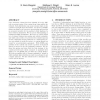Free Online Productivity Tools
i2Speak
i2Symbol
i2OCR
iTex2Img
iWeb2Print
iWeb2Shot
i2Type
iPdf2Split
iPdf2Merge
i2Bopomofo
i2Arabic
i2Style
i2Image
i2PDF
iLatex2Rtf
Sci2ools
115
click to vote
DRM
2004
Springer
2004
Springer
Analysis of an incentives-based secrets protection system
Once electronic content has been released it is very difficult to prevent copies of the content from being widely distributed. Such distribution can cause economic harm to the content’s copyright owner and others. Our protocol, SPIES, allows one party to sell a secret to second party and provides an economic incentive for two parties to limit sharing of a secret between themselves. We do not use watermarking or traditional DRM mechanisms. We focus on content which is to be shared between two parties only, which is valuable, and which only needs to be protected for a limited amount of time. Examples include passwords to a subscription service, pre-release of media for review, or content shared but bound by a non-disclosure agreement. With SPIES, any possesor of the content can receive a portion of the funds placed in escrow by the two legitimate possesors. We analyze this system and show that the best strategy of the content provider and content consumer to maximize their utility is ...
Related Content
| Added | 01 Jul 2010 |
| Updated | 01 Jul 2010 |
| Type | Conference |
| Year | 2004 |
| Where | DRM |
| Authors | N. Boris Margolin, Matthew Wright, Brian Neil Levine |
Comments (0)

